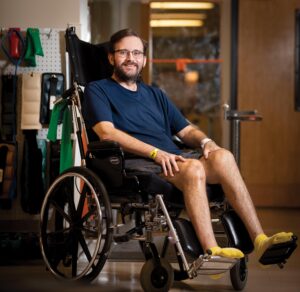COVID recovery included long stay on ECMO, double-lung transplant

Zach Lloyd was only 37 years old with no preexisting health conditions, but COVID-19 brought him within an inch of his life.
Beginning in October 2020, he lay immobile in a bed at Vanderbilt University Medical Center, hooked up to a life-sustaining mechanical system called ECMO, or extracorporeal membrane oxygenation, which can temporarily take over for the heart and lungs of critically ill patients. He primarily needed it for his lungs, badly damaged by the coronavirus.
He would remain on the system for 95 days, far exceeding the time most patients spend on it. In a rare move, Lloyd was on not one, but two ECMO circuits, a maze of tubes carrying blood back and forth, keeping him alive.
In January, Lloyd received a double-lung transplant that was his only shot at life. Lloyd looks back on spending more than four months in the hospital — including Thanksgiving, Christmas and his birthday — much of that time fighting for his life.
“Without the dedicated actions of the COVID-19 Intensive Care Unit, Medical Intensive Care Unit (MICU), Cardiovascular Intensive Care Unit (CVICU), and ECMO teams, he would not be alive today. They literally gave him a chance to live,” said Lloyd’s transplant surgeon, Matthew Bacchetta, MD, MBA, MA, chair of the Department of Thoracic Surgery.
None of this made any sense. Why was a 37-year-old man with no known health conditions on the brink of lung failure because of COVID-19?
“I don’t think anybody knows why it impacted his lungs the way that it did,” said his wife, Sara. “Everybody is just dumbfounded by why.”
Lloyd’s lungs were badly damaged, and he needed a transplant, but he was also immobile. And there was little precedent for transplanting lungs into a COVID-19 patient — just a handful of cases nationally.
“In order to get listed for any kind of a transplant, the patient has to be pretty sick, but they also can’t be so sick that they won’t do well once they get the transplant,” said Jessica Bowman Williams, RN, CCRN, program coordinator in the CVICU, where Lloyd would spend time after the MICU. “In his case, his only option for survival was to get a lung transplant. But in order to get listed for transplant, he needed to prove that he could mobilize and rehabilitate.”
ECMO fellow Yatrik Patel, MD, proposed that Zach use a new supine bicycle. The bike, which the CVICU had just acquired, allows patients to essentially pedal in a hospital bed. Zach took to the bike immediately, setting goals for time on the bike and resistance, just as he would do on his stationary bike at home, which happened to be his exercise of choice.
“Even on weekends and holidays, Yatrik and I coordinated and met in the MICU to get Zach on the bike,” Williams said. “It was precarious with the two ECMO circuits (two large cannulas went into bilateral groins while two additional cannulas went into his internal jugular veins in his neck), but we made it happen as safely as possible while getting him mobilized. Sometimes some of our CVICU nurses would go up with the bike as well, if I could not. It was a team investment in his mobility.”
Lloyd spent enough time on the bike to attract the notice of the transplant committee that determines who will be good candidates for transplants, and Lloyd passed the test. He was placed on the transplant list on Christmas Eve, and Bacchetta transplanted his two new lungs on Jan. 28. The cardiothoracic anesthesia team included Bantayehu Sileshi, MD, associate professor of Anesthesiology, and fellow Karl Hillenbrand, MD.
Lloyd recalled his pulmonologist, Katie McPherson, MD, assistant professor of Medicine, describing them as a perfect match — like having a No. 1 draft pick and being able to pick Tom Brady or Peyton Manning.
“Essentially we were waiting for perfect lungs,” McPherson said. “When we found them, we went for it because it was Zach’s only chance at survival.”
After 124 days as an inpatient, Lloyd was released to begin his physical rehabilitation at Vanderbilt Stallworth Rehabilitation Hospital. He was discharged from inpatient rehab in April, and in July he resumed preaching at East LaFolette Baptist Church.
“If there’s anything I could tell somebody, it is, have hope,” Lloyd said. “There’s been a lot of dark days, but have hope that eventually it’s going to be better.”
